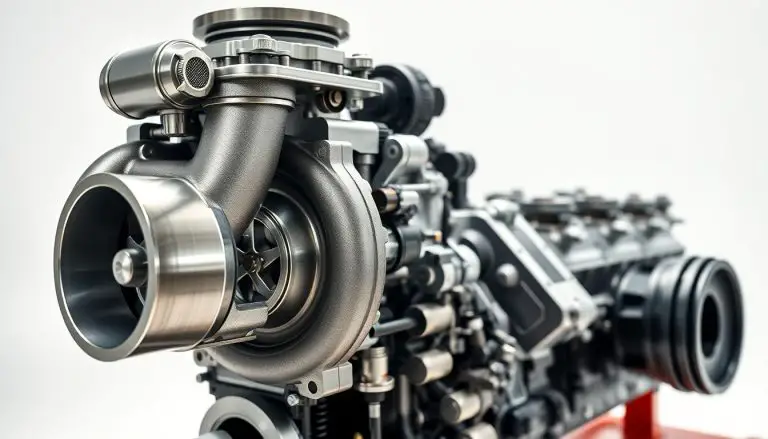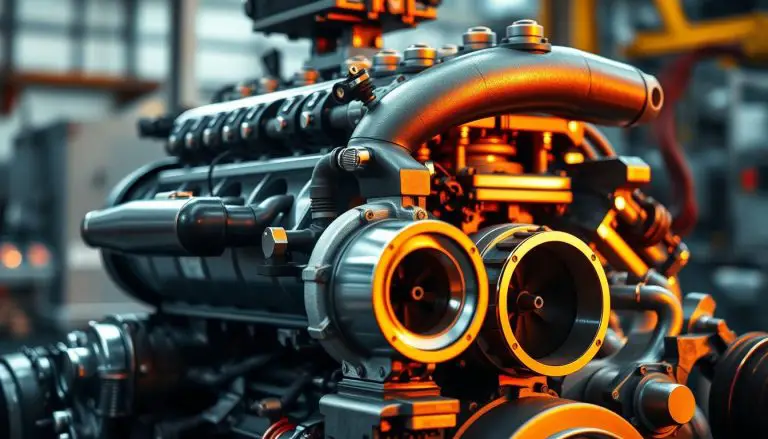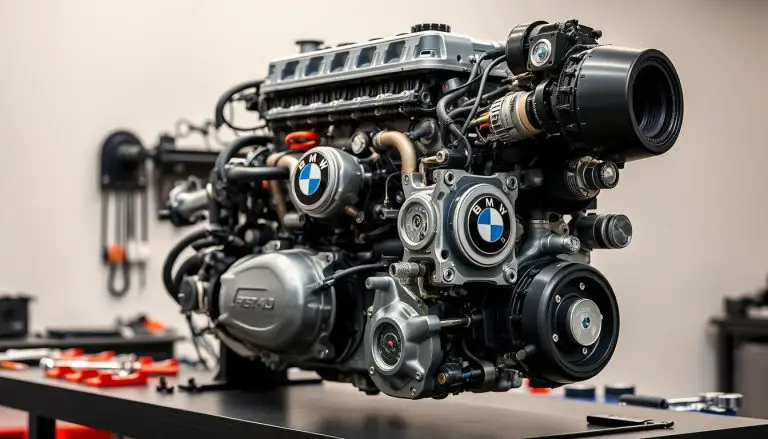The Duramax engine, a stalwart among diesel aficionados for its formidable power and enduring resilience, has been a cornerstone since its inception in 2001. Throughout its evolution, it has witnessed a plethora of enhancements and refinements.
Nonetheless, the Duramax is not immune to the vicissitudes inherent in all engines. Specific model years have been marred by engine maladies, rendering them less appealing to prospective buyers.
Grasping the narrative and prevalent challenges of the Duramax engine is paramount for those contemplating the acquisition of a pre-owned vehicle. This knowledge empowers buyers to navigate the complexities of the market with greater confidence.
Key Takeaways
- Overview of the Duramax engine history
- Common issues affecting certain model years
- Factors to consider when buying a used Duramax
- Tips for avoiding problematic models
- Importance of research in the purchasing process
Understanding the Duramax Engine Legacy
The Duramax engine’s history, spanning over two decades, is a testament to its pivotal role in diesel engine evolution. Since its debut in 2001 by General Motors, it has epitomized power, durability, and reliability, becoming an iconic symbol in the automotive industry.
The Evolution of Duramax Diesel Engines
Since its inception, the Duramax engine has undergone profound transformations. Initially, it was introduced as the LB7, marking the beginning of a lineage that has seen the introduction of subsequent generations, including the LLY, LBZ, LMM, LML, and L5P. Each iteration has brought forth enhancements in performance, efficiency, and compliance with emissions standards.
- LB7 (2001-2004): The inaugural generation, celebrated for its robust power and initial reliability.
- LLY/LBZ (2004-2007): This phase saw an uptick in performance, coupled with the advent of novel technologies.
- LMM/LML (2007-2016): This era focused on reducing emissions while enhancing performance further.
- L5P (2017+): The current generation, distinguished by significant advancements in power, efficiency, and emissions reduction.

Why Duramax Engines Remain Popular
Despite the hurdles faced by certain model years, Duramax engines continue to captivate diesel aficionados. Their enduring reputation for durability, bolstered by robust aftermarket support and a vibrant community, solidifies their status as a preferred option.
The factors driving their enduring popularity are multifaceted:
- Performance and Power: Renowned for their formidable towing and hauling prowess, Duramax engines stand out.
- Aftermarket Support: An extensive array of aftermarket parts and modifications is available, empowering owners to personalize their engines.
- Community and Reliability: The Duramax community is fervent and supportive, with numerous owners sharing their experiences and modifications.
Duramax Years to Avoid: An Overview
When contemplating the acquisition of a Duramax engine, it is imperative to recognize certain model years as notably troublesome. The Duramax engine, a cornerstone in the diesel truck sector, has undergone a plethora of transformations, some of which have precipitated substantial reliability concerns.

Common Issues Across Problematic Years
Multiple Duramax model years are beset by recurring maladies, including injector failure, head gasket problems, and transmission weaknesses. These afflictions frequently emanate from design imperfections or manufacturing anomalies, which were later rectified by the manufacturer.
For example, the LB7 (2001-2004) is notorious for injector failures, whereas the LLY (2004.5-2005) grappled with overheating issues, attributed to inadequacies in the cooling system.
The Impact of Design Changes on Reliability
Design modifications have profoundly influenced the dependability of Duramax engines. Alterations to the engine’s design, such as revisions to the fuel system or the integration of emissions control systems, have sometimes introduced novel challenges.
The advent of the CP4 pump in subsequent models has been linked to high-pressure fuel pump failures, underscoring the significance of scrutinizing design changes’ repercussions on overall engine dependability.
Grasping these issues and the repercussions of design alterations on reliability is essential for prospective buyers aiming to circumvent problematic Duramax models.
The 2001-2004 LB7 Duramax: First Generation Problems
The LB7 Duramax, a pioneering model in the Duramax lineup, spanned from 2001 to 2004. Despite its groundbreaking status, it was marred by inherent flaws. As the inaugural model of the Duramax diesel engine series, it established a precedent for future iterations but concurrently introduced its own array of challenges.
Injector Failure Issues
The LB7 Duramax was notably plagued by injector failure. These fuel injectors were susceptible to malfunction, resulting in diminished performance, compromised fuel efficiency, and potential damage to other engine components. The root cause of this issue was often traced back to the intricate design of the fuel system and the elevated pressures it operated under.
Head Gasket and Water Pump Concerns
Aside from injector malfunctions, the LB7 Duramax also grappled with head gasket and water pump issues. Head gasket failures could precipitate coolant leaks, overheating, and severe engine damage if not swiftly rectified. Water pump failures, on the other hand, could induce overheating, necessitating expensive repairs.
To illustrate the common issues and their repair costs, consider the following table:
| Issue | Average Repair Cost | Potential Solutions |
|---|---|---|
| Injector Failure | $1,500 – $3,000 | Replace faulty injectors, consider aftermarket upgrades |
| Head Gasket Failure | $1,000 – $2,500 | Replace head gasket, inspect for other damage |
| Water Pump Failure | $500 – $1,200 | Replace water pump, inspect cooling system |
Average Repair Costs and Solutions
Grasping the average repair costs and potential solutions is paramount for the upkeep of an LB7 Duramax. While the expenditures can be substantial, early detection of issues and the adoption of superior repair methods can significantly reduce long-term financial burdens.
The 2004.5-2005 LLY Duramax: Overheating Concerns
The 2004.5-2005 LLY Duramax engine is infamous for its propensity to overheat, a condition that can irreparably damage the engine if not promptly rectified. This overheating phenomenon is attributed to a combination of cooling system inadequacies and inherent design flaws within the engine.
Cooling System Deficiencies
The cooling system of the LLY Duramax is identified as a primary culprit behind the engine’s overheating. Critics argue that the cooling system’s design falls short of meeting the engine’s thermal requirements, resulting in recurrent overheating episodes. Enhancing the cooling system’s components is a viable solution, albeit one that necessitates an initial investment.
EGR and Head Gasket Problems
The Exhaust Gas Recirculation (EGR) system and the design of the head gasket also play significant roles in the overheating issues. The EGR system’s propensity to generate excessive heat, coupled with head gasket failures that can lead to coolant leakage, further compounds the overheating problem. Ensuring the regular maintenance of the EGR system and vigilance for signs of head gasket failure are imperative.
“The LLY Duramax’s EGR system is a known weak point, and its failure can lead to catastrophic engine damage.”
Aftermarket Fixes and Their Effectiveness
Several aftermarket remedies have been developed to address the overheating issues plaguing the LLY Duramax. These include enhanced radiators, upgraded water pumps, and modified EGR systems. The efficacy of these solutions, while promising, is contingent upon the specific application and the vehicle’s overall condition.
One owner’s experience illustrates the potential benefits of such upgrades: “Installing a high-performance radiator and water pump significantly lowered my engine’s operating temperature.”
In summary, despite the 2004.5-2005 LLY Duramax’s susceptibility to overheating, a proactive approach combining awareness, regular maintenance, and aftermarket enhancements can help alleviate these concerns. Prospective buyers should be cognizant of these potential issues when contemplating the purchase of a used LLY Duramax.
The 2006-2007 LBZ Duramax: Transmission Weaknesses
The 2006-2007 LBZ Duramax, renowned for its enhanced performance and power, presents transmission issues that necessitate attention from owners. This model, favored by diesel enthusiasts, is marred by transmission weaknesses, posing significant maintenance challenges.
Allison Transmission Issues
The Allison 1000 transmission, paired with the LBZ Duramax, exhibits robustness but harbors its own set of challenges. Common afflictions include slipping and hesitation between gears, often stemming from worn-out clutch packs or faulty solenoid packs. Such maladies can precipitate unpredictable shifting patterns, compromising the driving experience.
Proactive maintenance, encompassing fluid checks and filter replacements, can alleviate some of these issues. Yet, when malfunctions occur, the cost of repairs can be substantial, frequently necessitating the replacement of major transmission components.
Fuel System Problems and Repair Options
Concomitant with transmission issues, the LBZ Duramax may also encounter fuel system problems. Clogged fuel injectors and faulty fuel pressure regulators are prevalent concerns, resulting in diminished engine performance and fuel efficiency. Routine cleaning and inspection of the fuel system can forestall these problems.
For those confronting fuel system maladies, repair options span from injector cleaning or replacement to the installation of aftermarket fuel system enhancements. These upgrades can augment performance and diminish the prospect of future complications.
In summary, despite its impressive power and performance, the 2006-2007 LBZ Duramax’s transmission weaknesses and fuel system problems mandate vigilant consideration and regular maintenance to ensure its longevity and reliability.
The 2007.5-2010 LMM Duramax: Emissions Headaches
The 2007.5-2010 LMM Duramax engine, celebrated for its robust performance, is beset by emissions-related maladies, notably DPF system failures. This engine, renowned for its efficiency and power, encountered formidable challenges stemming from its emissions control systems.
DPF System Failures
The Diesel Particulate Filter (DPF) system inherent to the LMM Duramax is susceptible to failures, resulting in exorbitant repair costs. The DPF’s purpose is to diminish soot emissions, yet it can become obstructed, precipitating engine performance diminutions.
Common symptoms of DPF failure include:
- Reduced engine performance
- Increased fuel consumption
- Error messages on the dashboard
Adherence to regular maintenance, encompassing DPF cleaning or replacement, can serve as a preventive measure against these maladies.
Fuel Dilution and Engine Wear
Fuel dilution, a critical concern for the LMM Duramax engine, manifests when diesel fuel infiltrates the engine’s oil system, diluting the lubricant and potentially inducing engine wear.
| Cause | Effect | Solution |
|---|---|---|
| Faulty injector | Fuel dilution | Replace injector |
| Poor engine maintenance | Increased engine wear | Regular oil changes |
Emissions Delete Considerations and Legal Implications
Some proprietors contemplate emissions deletion to circumvent the problems associated with the DPF system. Notwithstanding, this approach harbors significant legal repercussions.
It is imperative to recognize that tampering with emissions control systems is illegal in many jurisdictions, including the United States, and can incur substantial penalties.
Before embarking on any modifications, proprietors should engage with a professional mechanic and weigh the legal and environmental ramifications.
The 2011-2016 LML Duramax: CP4 Pump Disasters
The 2011-2016 LML Duramax is marred by a prevalent issue: CP4 pump failures. This malady has precipitated a plethora of grievances from vehicle proprietors, casting a shadow over its appeal for prospective buyers.
High-Pressure Fuel Pump Failures
The CP4 pump, integral to the LML Duramax engines, is susceptible to failure. Such occurrences necessitate the replacement of the fuel system, a costly endeavor. The etiology of these failures encompasses contamination and wear and tear, among other factors.
- Contamination of fuel
- Inadequate maintenance
- Manufacturing defects
Preventive measures include the utilization of high-quality fuel and diligent maintenance. Prospective buyers of used LML Duramax vehicles must scrutinize the vehicle’s maintenance history and inspect for any signs of fuel system malfunctions. For further insights, visit eBay.
DEF System and Emissions Control Issues
The 2011-2016 LML Duramax engines also grapple with DEF (Diesel Exhaust Fluid) system malfunctions. These issues can compromise engine performance and elevate emissions levels.
- Clogged DEF injectors
- Faulty DEF sensors
- Software glitches
These problems can be vexing for owners and may necessitate expensive repairs. Proactive maintenance and regular inspections are crucial for early detection of these issues.
Class Action Lawsuits and Warranty Coverage
The prevalence of CP4 pump failures and DEF system malfunctions has prompted class action lawsuits against the manufacturer. Affected owners may be entitled to compensation or extended warranty coverage.
It is imperative for owners to remain abreast of any ongoing litigation and to verify their warranty status. Maintaining a comprehensive record of maintenance and repairs can prove invaluable in the event of a claim.
The Most Reliable Duramax Years to Consider
In the realm of Duramax engines, certain model years emerge as paragons of performance and longevity. The evolution of the Duramax line has led to notable enhancements, rendering some models more coveted than others. This is due to their superior reliability and performance capabilities.
The LBZ Sweet Spot (2006-2007)
The LBZ Duramax, spanning from 2006 to 2007, is frequently regarded as a pinnacle of reliability. This engine is lauded for its sturdy construction and absence of the intricate emissions systems that often afflict other models. Its straightforward design, coupled with its formidable power output, endears it to Duramax aficionados. With diligent upkeep, these engines can traverse considerable mileage without encountering significant malfunctions.
Late Model L5P Advantages (2020+)
The L5P Duramax, prevalent in 2020 and subsequent models, embodies the zenith of Duramax innovation. This engine leverages cumulative design enhancements and cutting-edge technology to enhance both performance and efficiency. The L5P engine boasts an enhanced fuel system and superior emissions management, rendering it both potent and eco-conscious. These newer engines also benefit from extended warranties and manufacturer backing, offering reassurance to their proprietors.
Best Value-to-Reliability Ratio Years
When evaluating the intersection of cost and dependability, specific Duramax years emerge as more economical choices. The 2006-2007 LBZ models, renowned for their reliability, also command a lower price point compared to their newer counterparts, appealing to budget-conscious buyers. In contrast, the most recent L5P models, though pricier, offer the most advanced technology and warranty provisions, potentially offsetting repair expenses over time. Prospective buyers must assess these variables to identify the most cost-effective option for their requirements.
How to Inspect a Used Duramax Before Buying
The acquisition of a pre-owned Duramax engine necessitates a thorough inspection, encompassing several pivotal steps. This ensures a well-informed decision-making process.
Essential Diagnostic Tests and Scanner Codes
Initiate by executing essential diagnostic tests. Employ a scanner to scrutinize trouble codes within the engine control module (ECM). These codes offer insights into potential malfunctions, such as fuel system, emissions control, or engine performance issues. Focus on codes associated with the fuel pressure regulator and exhaust gas recirculation (EGR) system, as these are common Duramax engine concerns.
Warning Signs to Look For
During the inspection, vigilance for warning signs is paramount. These include unusual noises, excessive smoke from the exhaust, or signs of leaks around the engine. Inspect the engine oil and coolant for contamination or degradation. Also, examine the engine mounts for wear or damage, as failing mounts can cause increased vibration and engine damage.
Service Records and Maintenance History Importance
An examination of the service records and maintenance history of the used Duramax is indispensable. A detailed maintenance history assures the engine’s proper care. Seek records of regular oil changes, filter replacements, and any repairs or replacements of critical components. This information aids in understanding the engine’s condition and anticipating potential future issues.
By adhering to these steps and attentively observing diagnostic tests, warning signs, and maintenance history, a more informed decision can be made when purchasing a used Duramax engine.
Conclusion: Making an Informed Duramax Purchase Decision
Engaging in the acquisition of a pre-owned Duramax necessitates a comprehensive understanding of the inherent challenges across various model years. This knowledge empowers buyers to make a well-informed buying decision, aligning with their specific needs and financial constraints.
The evolution of the Duramax engine has introduced notable variations, with certain iterations exhibiting superior reliability and performance. The 2006-2007 LBZ and the late model L5P, for instance, have demonstrated enhanced capabilities. Such insights are paramount for a successful Duramax purchase decision.
Ultimately, a buyer who is well-informed can adeptly navigate the complexities inherent in the used Duramax market. Armed with the knowledge provided, they can circumvent common pitfalls and procure a model that fulfills their requirements.
FAQ
What are the most common problems with the Duramax engine?
The Duramax engine frequently encounters injector failure, head gasket malfunctions, and transmission vulnerabilities, among other issues.
Which Duramax years should I avoid?
It is advisable to steer clear of the 2001-2004 LB7, 2004.5-2005 LLY, and 2011-2016 LML models due to their inherent problems.
What is the most reliable Duramax model?
The LBZ Duramax, spanning from 2006 to 2007, is renowned for its durability and minimal issues, making it a preferred choice.
How can I inspect a used Duramax before buying?
To evaluate a used Duramax, conduct essential diagnostic tests, look for warning signs, and scrutinize service records and maintenance history.
What are the average repair costs for Duramax engines?
Repair expenses fluctuate based on the problem, but common repairs like injector replacement and head gasket repairs can be quite costly.
Are there any aftermarket fixes for Duramax problems?
Yes, aftermarket solutions exist for specific issues, such as cooling system deficiencies and EGR-related problems, though their efficacy can be inconsistent.
What are the legal implications of emissions deletes on Duramax engines?
Emissions deletions carry substantial legal risks, including potential penalties and warranty voidance, and should be approached with extreme caution.
How does the DEF system affect the Duramax engine’s performance?
The DEF system is vital for emissions control, and any issues with it can significantly impact the engine’s performance and overall reliability.
What are the advantages of the L5P Duramax engine?
The L5P Duramax, introduced in 2020, offers enhanced performance, reliability, and emissions control, making it an attractive option for those seeking a newer model.


